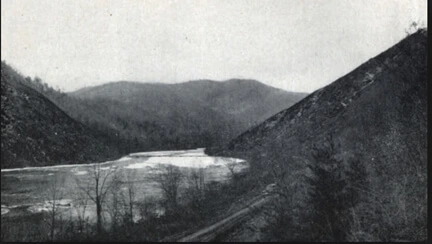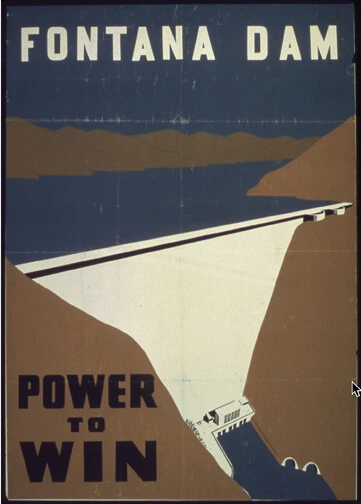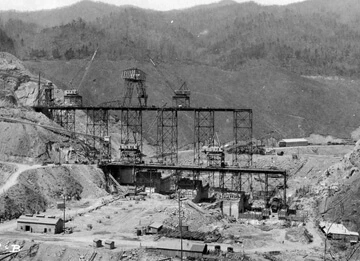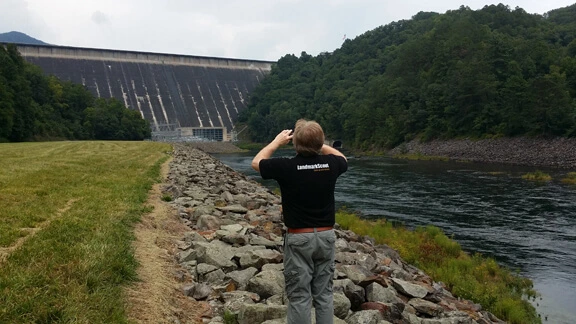By Cliff Leverette,
Beginning just after WW1, there was an American congressional effort to encourage industrial development in places like Eastern Tennessee, where, if war became imminent, those industries could convert to produce the massive weaponry that Americans had come to realize that future wars would be fought with. Eastern Tennessee was perfect: rural, mountainous and plenty of rivers that could provide the kind of electric power needed for the steel and aluminum and iron for war material that would be needed.
At the same time, another government agency, the Tennessee Valley Authority (TVA) was promoting the building of dams along those hundreds of miles of rivers for the purpose of controlling flooding that made erosion a real threat to American farming. In addition, the TVA saw that there was a great potential for producing electricity at those dams, sending electricity to rural farmers who lived well away from areas where Electricity was becoming a necessity as well as a luxury.
The Aluminum Company of America (ALCOA) became involved in producing aluminum for peacetime items and had been drawn to an area adjacent to Knoxville, Tennessee. There, they developed a small town known as Alcoa, in between Knoxville and the town of Maryville which was just outside the Appalachian Mountain region that was in the process of becoming the Great Smoky Mountains National Park.

ALCOA wanted to make sure that it had adequate electricity of its own use so while the TVA was building dams with hydroelectric capacity in Tennessee, ALCOA looked eastward across the Smoky Mountains into a valley in North Carolina where there was a convergence of many mountain streams and smaller rivers forming the headwaters of the Little Tennessee River. ALCOA purchased land and plans made for the building of the hydroelectric dam that would touch the Great Smoky Mountains National Park on the west. Happily for ALCOA there was a dispute in the Federal government about letting private business build large dams that could control flooding and produce electricity versus the Federal government with agencies such as the TVA which had a history building dams for such purposes. It was decided finally that the TVA should take over the plans to build the dam. In exchange for giving up the rights to the dam, the TVA had to guarantee that ALCOA would be recieve half of the electricity produced from it. The TVA expanded the project to be many times larger than ALCOA, taking in a number of small towns and villages and private farms, displacing thousands of people, many of whom had just moved into those mountain communities after being forced out of the area as it became the Great Smoky Mountains National Park.

As these things were happening, the war in the Pacific and in Europe had made Americans see that eventually they would become involved on the side of their allies. ALCOA realized that war weaponry, ships, tanks and planes as well as individual soldiers’ equipment would all need lightweight aluminum. Therefore ALCOA made a critical decision to rapidly expand production on an unheard of scale.
However, the new dam in North Carolina was not built and ALCOA still had to rely on getting its electricity from sources along the headwaters of the Tennessee River as well as from the dams on that river. And as war involvement came ever nearer, it might have become apparent that with all the war material production work that was going to be necessary, manpower for building the new dam, now called Fontana, might be difficult to find.

There was one other government project beginning in earnest at the time, one which was the most secret undertaking on the part of the United States and Britain of the entire war. In looking for places where the secret work could be conducted those who were responsible for coming up with sites also came to look at East Tennessee for its needs. It would be so secret that the workers who would run and service the plant had to stay on the property of the plant so that news of what they were doing would not easily leak out. Initially the site would receive the name Kingston Demolition Range which was then changed to the Clinton Engineer Works while it would become known simply as Oak Ridge. For the most part, the people working there were civilians and their families would have to come in with them and be able to live as normal a life as possible. Schools, playgrounds, grocery stores, everything a person would find in a regular town, had to be available. Eventually, however, when everything was up and running, high school students from the area outside Oak Ridge were given jobs running some of the machines even though they had no idea what the machines were making.
This secret site was a part of the Manhattan project. Most people know that Los Alamos was the place where the Atomic Bombs were built and tested, but all of the parts had to be made elsewhere. And there is one thing that an atomic bomb must have to be an atomic bomb: plutonium. Simply speaking, plutonium is made from uranium, and as the project started scientists did not yet know the most efficient way to produce large amounts of plutonium but three main theories were developed. All over the United States, manufacturing plants, both private and government owned, were employed to make the various parts but the most difficult and dangerous were those that were to attempt to make plutonium using one one type of the three theoretic methods. But at Oak Ridge, all three types of manufacturing plants were built which were able to produce plutonium, but with vastly different results. Therefore, Oak Ridge became the place where the most plutonium was produced.
Because of the rush to produce Plutonium, plans were changed to build Fontana dam to generate an enormous electric output for both ALCOA and Oak Ridge. The dam itself is the single tallest manmade structure of its kind in the eastern United States and remains the world’s fourth largest single producer of electricity. And this feat of engineering and construction took less than two years to build. Just as the town of Alcoa had grown out of the ALCOA plant and expansion, Oak Ridge grew out of the Manhattan Project. Fontana Village grew out of the need to house the workforce that was needed to build this enormous project in such a short time. It was completed in time to help both ALCOA and Oak Ridge function as successful war industries.



For some time after the war, Oak Ridge continued to be a very secretive place and the role of Fontana Dam, providing much of the electricity for arming the Atomic bombs which ended the war was secret as well.
Visit
Oak Ridge is open for visits, its need for secrecy over, and the area around Fontana Dam is a semi-wilderness with the National Park on one side and the Nantahala National Forest on the other. Fontana Village has become a rustic resort. For hikers walking the famous (of infamous) Appalachian Trail, Fontana Dam itself is part of the trail and includes a marble lined shower house for hikers to use at no cost. I’ve used the shower house, I’ve hiked the trial through the Smokies and across Fontana Dam and it is quite the mental treat, if not torture for the body!
So I won’t get into trouble with any Europeans who this may appeal to, a word of warning. My daughter and I hiked the Appalachian Trail (AT) from Clingman’s Dome to Fontana Dam in 2007. Not long after we started, we were met by a horrible looking hiker with insect bites, cuts and bruises. He was just barely making his way along, up the steep and sometimes dangerous southern slope of Clingman’s Dome. He looked angry and he was. He was from Holland who had heard about the AT and had supposed that it would be like European trials where there was a place to stay like a hostel at the end of a day’s hike. He had started more than 200 miles south, which I give him my respect. But he had not planned for what he was going to be doing and now he was paying the price. From a physical standpoint the worst of his problems were that the bugs that had bitten him every day were bugs he had no immunities from. He needed a strong repellant and some after-bite Benadryl cream or gel for when the bugs do get past the repellant. He was literally an infected, itchy mess. So, if you are still fascinated by the idea of hiking a trail that will make you feel like the world is still a vast wilderness, do find out about the bugs and what you need to make the hike safe and enjoyable, okay?


Update: Because LandmarkScout shows WW2 locations, what they look like today, I wanted to post a link to more of the Manhattan Project sites, Oak Ridge Laboratories (which Fontana Dam supplied the electricity) and Los Alamos, where the bombs were designed, built and tested.